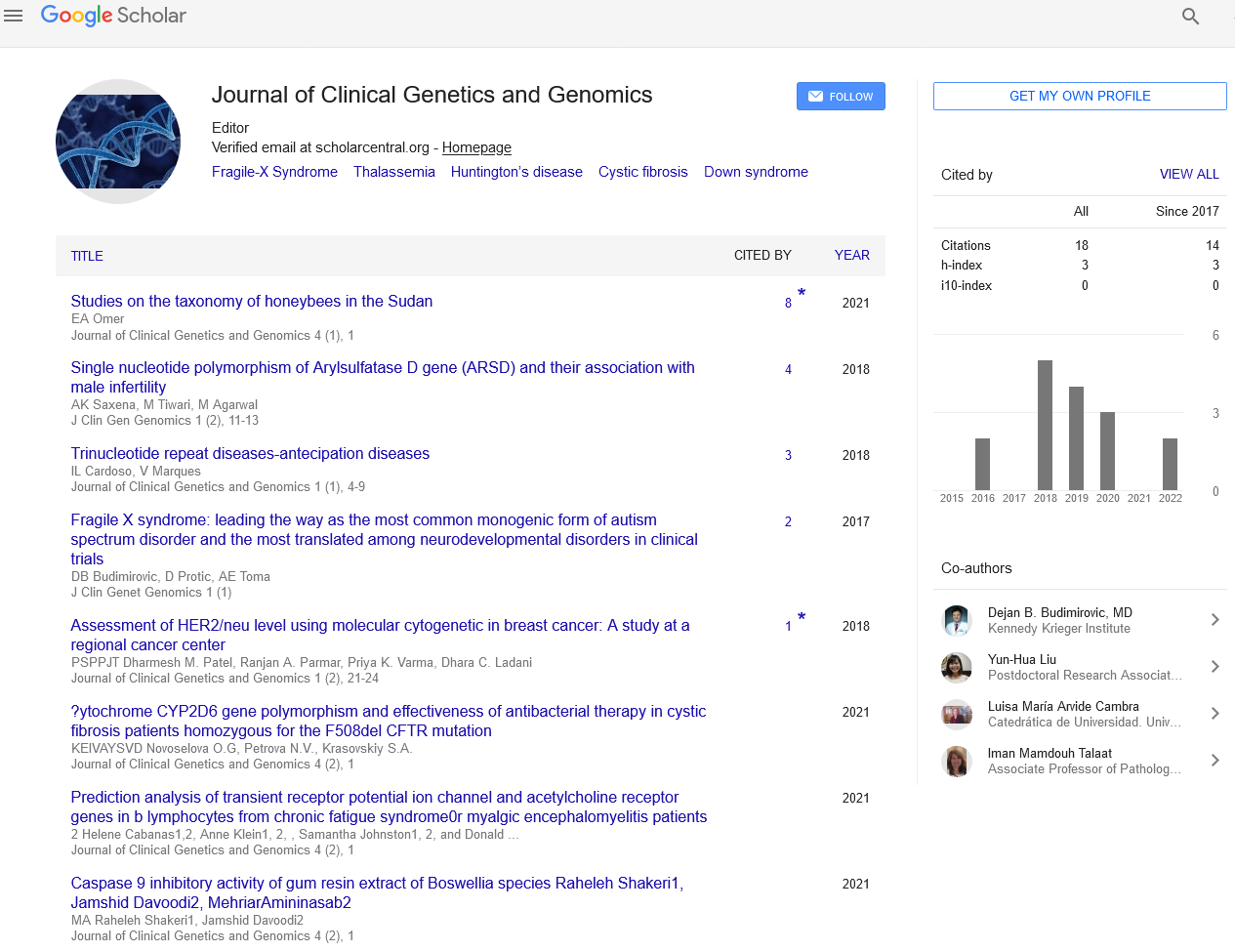Two Inherited Forms of Pulmonary Fibrosis and Their Immunome
Received: 06-Apr-2022, Manuscript No. PULJCGG-22-5778; Editor assigned: 08-Apr-2022, Pre QC No. PULJCGG-22-5778 (PQ); Accepted Date: Apr 17, 2022; Reviewed: 12-Apr-2022 QC No. PULJCGG-22-5778 (Q); Revised: 15-Apr-2022, Manuscript No. PULJCGG-22-5778 (R); Published: 20-Apr-2022, DOI: 10.37532. puljcgg.22.5 (2).1-2
Citation: Davies G . Two inherited forms of pulmonary fibrosis and their immunome J. Clin. Genet. Genom. 2022 5(2):1-2.
This open-access article is distributed under the terms of the Creative Commons Attribution Non-Commercial License (CC BY-NC) (http://creativecommons.org/licenses/by-nc/4.0/), which permits reuse, distribution and reproduction of the article, provided that the original work is properly cited and the reuse is restricted to noncommercial purposes. For commercial reuse, contact reprints@pulsus.com
Abstract
Incomplete definitions exist for the immunome (serum cytokine profiling, immune cell phenotype, and gene expression) in pulmonary fibrosis. Research on inherited types of pulmonary fibrosis sheds light on the general mechanisms underlying fibrotic lung disease. Highdimensional flow cytometry and large-scale gene expression of peripheral blood mononuclear cells were performed and compared in a cohort with Familial Pulmonary Fibrosis (FPF), an autosomal dominant disorder with incomplete penetrance; Hermansky-Pudlak Syndrome Pulmonary Fibrosis (HPSPF), a rare autosomal recessive disorder; and their unaffected relatives in order to define the cellular and molecular immunologic phenotype in According to our findings, patients with FPF had elevated peripheral blood levels of activated central memory helper cells. Patients who had either familial or HPSPF antibodies had higher proportions of CD38+ memory CD27+ B-cells, IgA+ memory CD27+ B-cells, IgM+ and IgD+ B-cells, and CD39+ T helper cells, whereas lower proportions of CD39 T helper cells were present. In addition to changed levels of various analytes, such as leptin, cytokines, and growth factors, gene expression and serum proteomic studies of circulating mononuclear cells revealed enrichment of upregulated genes linked to mitosis and cell cycle control. The extra-pulmonary immune system's dysregulation is a phenotypic trait of FPF or HPSPF, to sum up. To understand the role of immune system dysregulation in the aetiology of pulmonary fibrosis, more research on the blood immunome is recommended
Key Words
Serum cytokine; Cytokenin; Dysregulation; Pulmonary; Immunologic
Introduction
chronic interstitial lung illness pulmonary fibrosis, which has no known cause, has a dismal prognosis and frequently results in lung The transplantation or death from respiratory failure. Having no recognised risk factors, idiopathic pulmonary fibrosis is a prevalent kind of genetically heterogeneous fibrotic lung disease that mainly affects elderly people. Studies concentrating on hereditary monogenic or oligogenic illnesses associated with highly penetrant fibrotic lung disease in younger subpopulations may provide insights into the pathophysiology of pulmonary fibrosis. Hermansky-Pudlak Syndrome (HPS) and Familial Pulmonary Fibrosis (FPF) are two hereditary illnesses that could be used as study models for pulmonary fibrosis. Less than 5% of people with idiopathic pulmonary fibrosis have familial pulmonary fibrosis, which is defined as the onset of pulmonary fibrosis of unknown cause in two or more first-degree relatives. This condition is inherited autosomally dominantly with partial penetrance. Patients with FPF often have symptoms in their sixth decade of life, and one to two decades before symptoms appear, interstitial lung disease can be recognised in its preclinical stage. There is no known cause of FPF; however, monoallelic mutations in TERT, TERC, RTEL1, PARN, DKC1, or TINF2 and short telomeres are related to telomere disease or dyskeratosis congenita in a subpopulation. There are FPF families, including those with mutations in the genes encoding surfactant proteins (such as SFTPC and SFTPA2), and others that do not have telomere-related diseases.
rare multisystem autosomal recessive disorder Hermansky-Pudlak syndrome has defective lysosome-related organelle biogenesis. The Adaptor Protein-3 complex and the Biogenesis of Lysosome-Related Organelles Complex (BLOC)-1, BLOC-2, and BLOC-3 are two of the ten genetic types that have been identified. Oculocutaneous albinism, a tendency to haemorrhage because of a problem with the platelet storage pool, and colitis are only a few of the clinical symptoms seen in patients with different kinds of HPS. Neutropenia, immunodeficiency, and pulmonary fibrosis are examples of HPS-typespecific symptoms. Middle-aged adults with the BLOC-3 disorders HPS-1 and HPS-4, as well as children and young adults with the Adaptor Protein-3 Complex deficiency-related HPS-2, experience progressive pulmonary fibrosis. In pulmonary fibrosis, the alveolar milieu contains phenotypic changes in lung inflammatory cells that may aid in the progression of the illness. In contrast to healthy volunteers, CD11b+ alveolar macrophages isolated from patients with idiopathic pulmonary fibrosis can transdifferentiate into lymphatic endothelial cells in a laboratory setting. Additionally, in patients with a telomerase mutation, alveolar inflammation occurs decades before the onset of fibrotic lung disease, and alveolar lymphocytosis with activated CD4+ cells is a characteristic of preclinical FPF. Ground glass opacifications are visible on High-Resolution Computed Tomography (HRCT) images of individuals with HPS-1 lung illness, which may be a sign of alveolar inflammation.
These results are supported by the observation that HPS-1 is connected to high levels of bronchoalveolar lavage cells, alveolar macrophage activation, and fibrogenic mast cells. According to these findings, immune cell dysfunction and influx into lung tissue are characteristics of people who are at a high risk of developing inherited pulmonary fibrosis. This can cause alveolar damage and the onset of early lung fibrosis. We looked examined the immunome and immune cells in peripheral blood from individuals with these inherited fibrotic lung disorders in light of the results of dysregulated immune cells in the lungs of patients with FPF and HPS-1 pulmonary fibrosis. In this cohort, we detect high levels of activated T-cell and B-cell subpopulations coupled with elevated cytokine levels. Leptin levels were high, and enriched and elevated gene expression in Peripheral Blood Mononuclear Cells (PBMCs) associated with mitosis and cell replication supported these findings.





